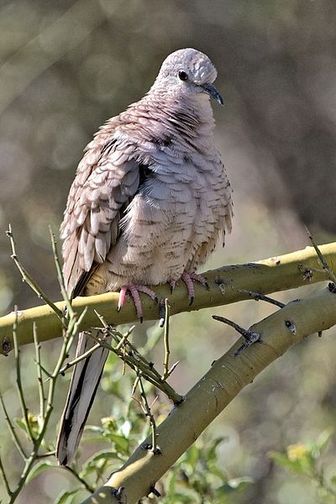Inca Dove
Inca Doves reach a length of 16.5 cm and weigh 47-48 g . They are slender, with a gray-brown body covered in feathers that resemble a scaled pattern. The tail is long and square, edged with white feathers that may flare out in flight. In flight, the underwing is reddish, like other ground doves, and on takeoff, the wings produce a distinctive, quiet rattling noise.

The Inca Dove is classified as Least Concern. Does not qualify for a more at risk category. Widespread and abundant taxa are included in this category.
The Inca Dove (Scardafella inca) is a small New World dove; it might belong to the genus Columbina. It ranges from the southwestern United States and Mexico through Central America to Costa Rica; the Inca Dove only lives on the Pacific side of Central America. Despite being named after the Inca Empire, this species does not occur in any of the lands that constituted that region. Inca Doves are common to abundant within their range and they are expanding their range north and south. More
A small tropical dove of arid areas, the Inca Dove has become a common resident of urban areas of the Southwest. It has expanded its breeding range northward and southward, but has remained attracted to towns and cities. More
the Inca Dove: Adaptive Aspects of Day-Night Differences. The Condor 89(1):185-187. References - * BirdLife International (2004). Scardafella inca. 2006. IUCN Red List of Threatened Species. IUCN 2006. www.iucnredlist.org. Retrieved on 09 May 2006. More
In the winter, Inca doves gather in flocks of up to 50. On cold winter days they have been known to form pyramids 2 or 3 tiers high in order to stay warm. During courtship, the male inca dove bows, coos and struts in front of the female, fanning his tail feathers. Males battle furiously for females. More
Inca Doves at the Fort Worth Zoo The Fort Worth Zoo keeper said the Inca Doves were temporarily removed from the exhibit because they did not get along with the roadrunners and other birds. The Inca Doves were skittish and continued to flap their wings disrupting the habitat. They have now been returned to the aviary in the Texas Wild exhibit. More
Adult Inca Dove on a lawn. More
Bent Life History for the Inca Dove - the common name and sub-species reflect the nomenclature in use at the time the description was written. INCA DOVE SCARDAFELLA INCA INCA (Lesson) HABITS CONTRIBUTED by CHARLES WENDELL TOWNSEND The charming little Inca dove, sometimes called the scaly dove, or the long-tailed dove, after characteristic features, is a bird of Tropical and Lower Sonoran Zones and occurs in the United States only in Arizona, New Mexico. and Texas. More
A fact from Inca Dove appeared on Wikipedia's Main Page in the Did you know? column on 19 December 2005. The text of the entry was as follows: "Did you know * ... More
Inca Doves are common to abundant within their range and they are expanding their range north and south. Inca Doves reach a length of 16.5 cm (6.5-8.25 in) and weigh 47-48 g (1.6 oz). They are slender, with a gray-brown body covered in feathers that resemble a scaled pattern. The tail is long and square, edged with white feathers that may flare out in flight. More
The Inca Dove is native to Guatemala, Costa Rica, El Salvador, Mexico, Nicaragua and Honduras. It is also sometimes a visitor to Canada and Belize. The range of this bird species is almost 3 million square kilometers. The population of the Inca Dove is estimated at almost 2 million individuals. The previous rating for the Inca Dove was Lower Risk. That rating was downgraded to Least Concern due to the size of the population and range of the Inca Dove. More
* Inca Dove videos on the Internet Bird Collection More
inca dove nest high in tree 47. inca dove nest high in tre... * inca doves sun bathing, one is thru inca doves sun bathing, one is... More
Inca Doves reach a length of 16.5 cm (6.5-8.25 in) and weigh 47-48 g (1.6 oz). They are slender, with a gray-brown body covered in feathers that resemble a scaled pattern. The tail is long and square, edged with white feathers that may flare out in flight. In flight, the underwing is reddish, like other ground doves, and on takeoff, the wings produce a distinctive, quiet rattling noise. More
Inca Doves look like Common Ground-Doves (Columbina passerina), but Inca Doves have longer tails, and the entire edge of the Inca Dove tail is white. These doves are small, not much bigger than the sparrows and finches they displace at seed feeders. Favored Habitat: Urban areas. Where to Find: Parks, lawns, bird feeders. Inca Dove (Columbina inca) Red shows in the extended wings. More
United States, the Inca Dove has extended its range both north and south over the past 100 years. A conspicuous urban resident, it commonly occurs at bird feeders and on lawns and other short grass habitats. This species was originally confined to arid habitats, and its affinity to human dwellings was attributed to the easy availability of water. It continues to spread into wetter areas, retaining its attachment to towns and cities for no obvious reason. More
Inca DoveThe Inca Dove (Columbina inca) is a small New World dove. Formerly classified under the genus Scardafella, recent genetic analyses indicate that both Scardafella doves belong with the other ground doves in the genus Columbina. It ranges from the southwestern United States and Mexico through Central America to Costa Rica. Despite being named after the Inca Empire, this species does not occur in any of the lands that constituted that region. More

Original source: www.naturespicsonline.com
Author: www.naturespicsonline.com
Permission: Some rights reserved
Family : Columbidae
Genus : Columbina
Species : inca
Authority : (Lesson, 1847)

